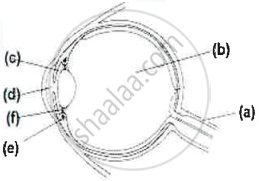Advertisements
Advertisements
Question
Select the odd one in the following series:
Retina, Sclera, Ciliary body, Nephron.
Solution
Nephron
APPEARS IN
RELATED QUESTIONS
Where is the image formed in a human eye?
Name two types of cells in the retina of an eye which respond to light.
What is the least distance of distinct vision for a normal human eye?
How does the convex eye-lens differ from the ordinary convex lens made of glass?
What happens to the size of pupil of our eye (i) in dim light (ii) in bright light?
The human eye possesses the power of accommodation. This is the power to:
(a) alter the diameter of the pupil as the intensity of light changes
(b) distinguish between lights of different colours
(c) focus on objects at different distances
(d) decide which of the two objects is closer.
The size of the pupil of the eye is adjusted by:
(a) cornea
(b) ciliary muscles
(c) optic nerve
(d) iris
When is a person said to have developed cataract in his eye? How is the vision of a person having cataract restored?
What are the advantages of having two eyes instead of just one?
Give scientific reason:
We cannot clearly see an object kept at a distance less than 25 cm from the eye.
State the main functions of the following:
Coronary Artery
Define the following:
Yellow spot
Give the main function of the following:
Lachrymal glands
Choose the correct answer.
Which one is the photoreceptor _____________
Write scientific reason.
The movie cannot be enjoyed if seat of a viewer is too close to the screen in the cinema.
Complete the paragraph by choosing the right options given below.
(minimum, near point, 25 cm, farthest, farthest distance, far point)
The _______ distance of an object from a normal eye, at which it is clearly visible without stress on the eye, is called the minimum distance of distinct vision. The position of the object at this distance is called the _______ of the eye, for a normal human eye, the near point is at _______. The _______ distance of an object from a human eye, at which it is clearly visible without stress on the eye is called _______ of distinct vision. The position of the object at this distance is called the _______ of the eye.
The black opening between the aqueous humour and the lens is called ____________.
Given below is a cross section of the human eye. Match the structures marked (a) to (e) with their correct functions:
Example: (f) - 6. Holds the lens in position
| Cross section of Human Eye | Functions | |
 |
1. | Protects retina |
| 2. | Regulates the size of the pupil | |
| 3. | Alters the shape of the lens | |
| 4. | Keeps the lens moist | |
| 5. | Transmits nerve impulses to brain | |
| 6. | Holds the lens in position |
State the functions of the following:
Ciliary muscles
Match the following:
| Column - I | Column - II |
| 1. Retina | a. Path way of light |
| 2. Pupil | b. Far point comes closer |
| 3. Ciliary muscles | c. near point moves away |
| 4. Myopia | d. Screen of the eye |
| 5. Hypermetropia | e. Power of accommodation |
